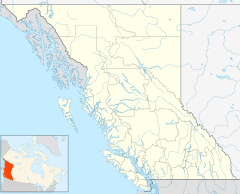Fort Berens facts for kids
Quick facts for kids
Fort Berens
|
|
|---|---|
| Country | |
| Province | BC/BCE |
Fort Berens, sometimes spelled Fort Behrens, was a trading post that was planned but never fully built. It belonged to the Hudson's Bay Company, a very old and famous Canadian trading company. This planned fort was located right across the Fraser River from where the town of Lillooet, British Columbia is today. This area is in the central Fraser Canyon region of British Columbia, Canada.
Contents
What Was Fort Berens?
Fort Berens was meant to be a supply center. It was planned in 1859 during the exciting time of the Fraser Canyon Gold Rush. Many people came to this area looking for gold. The fort would have provided them with goods and supplies. This part of the Fraser River was a main spot for gold-mining during the rush, which lasted from 1858 to 1860.
Why Was it Never Built?
Even though a piece of land was set aside for Fort Berens, and building materials were brought there, the fort was never finished. By 1861, the gold rush was ending. There were not enough miners left to make the fort profitable. The Hudson's Bay Company decided to stop the project. All the building supplies were then moved away.
Who Was it Named After?
Fort Berens was connected to another trading post called Fort Kamloops. It was like a smaller, "satellite" post. The fort was named after Henry Hulse Berens. He was an important leader in the Hudson's Bay Company. He served as the deputy governor from 1856 to 1858. Then, he became the governor from 1858 to 1863.
Nearby Gold Rush Towns
Right next to where Fort Berens was supposed to be, there were two "boomtowns." These were towns that grew very quickly because of the gold rush. Their names were Parsonville (or Parsonsville) and Marysville. Just like Fort Berens, these towns also disappeared when the gold rush ended. However, the name Parsonville was still used for a while for a tobacco farm in the area. A special cable ferry helped people cross the Fraser River. It connected the town of Lillooet with these three places on the east side of the river. A route to the Cariboo region, known as the Old Cariboo Road, also started from the east bank. This road went through Pavilion and Clinton to Alexandria.


